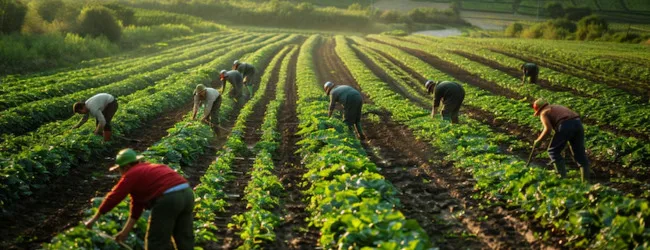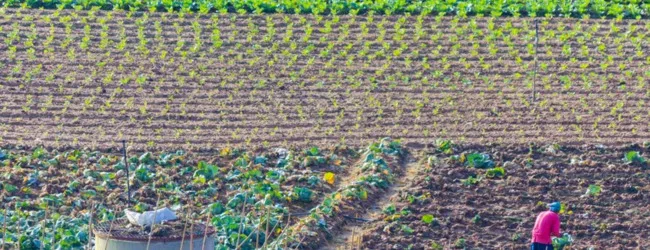Table of contents
Agriculture, in its diverse forms, sustains human civilization. Among the various agricultural practices, plantation farming stands out as a specialized system focused on large-scale cultivation of single cash crops. These vast agricultural estates, often stretching across hundreds or even thousands of acres, play a significant role in global commodity markets and the economies of many regions. This article delves deep into the intricacies of plantation farming, exploring its definition, unique characteristics, the variety of crops grown, its advantages and disadvantages, and how it distinguishes itself from other commercial farming methods.
What is Plantation Farming?

Plantation farming is a type of commercial agriculture where a single cash crop is grown on a large estate or plantation. This system is characterized by its focus on maximizing the output of a specific crop for sale in national and international markets. Historically, plantation farming was often associated with colonial agriculture, where crops like sugarcane, cotton, and tea were cultivated using large labor forces, often under exploitative conditions. While the socio-political landscape has evolved, the core principles of large-scale, monoculture production for profit remain central to modern plantation farming.
Characteristics of Plantation Farming
Plantation farming possesses several distinctive characteristics that set it apart from other agricultural practices:
- Large-Scale Estates: This is perhaps the most defining feature. Plantations typically cover extensive areas of land, often requiring significant capital investment for land acquisition and development. The sheer scale allows for economies of scale in production and management.
- Single Crop Cultivation (Monoculture): Plantations primarily focus on growing a single cash crop, such as rubber, tea, coffee, cocoa, oil palm, bananas, or pineapples. This specialization allows for focused expertise, efficient management tailored to the specific needs of the crop, and streamlined harvesting and processing. However, it also carries risks associated with pest outbreaks, soil nutrient depletion, and market price fluctuations for that single commodity.
- Capital Intensive: Establishing and maintaining a plantation requires substantial capital investment. This includes the cost of land, machinery (tractors, harvesters, processing equipment), irrigation systems, fertilizers, pesticides, and labor management.
- Labor Intensive (Historically and in Some Regions): While mechanization is increasingly common in many modern plantations, historically, and in some developing regions today, plantation farming relies on a large workforce for various tasks, including planting, weeding, harvesting, and processing. Labor management and costs are significant considerations.
- Scientific Methods and Modern Technology: To maximize productivity and efficiency, plantation farming often employs scientific methods of cultivation, including soil testing, selective breeding of high-yielding varieties, precise irrigation and fertilization techniques, and pest and disease management strategies. Modern technology, such as GPS-guided machinery and remote sensing, is also increasingly being adopted.
- Market-Oriented Production: The primary goal of plantation farming is commercial profit. The entire production process, from planting to processing and packaging, is geared towards selling the produce in regional, national, or international markets. Strong linkages with processing industries and transportation networks are crucial.
- Specialized Management: Managing a large-scale plantation requires specialized knowledge and skills in agronomy, finance, labor management, and marketing. Often, plantations are managed by professional agricultural companies or estate managers.
- Long Gestation Periods (for some crops): Certain plantation crops, like rubber, tea, and oil palm, have long gestation periods before they start yielding commercially. This requires long-term investment and planning.
💡Pro Tip: If you want to start a business but have too many doubts, connect with a business expert from Boss Wallah for guidance – https://bw1.in/1116
Types of Crops Grown in Plantation Farming

Plantation farming is well-suited for a variety of cash crops that thrive in tropical and subtropical climates. Some of the most common crops grown in plantation agriculture include:
- Beverage Crops: Tea, Coffee, Cocoa
- Fiber Crops: Rubber
- Fruit Crops: Banana, Pineapple
- Oil Seed Crops: Oil Palm
- Spices: Certain spices like cloves and nutmeg are also grown on a plantation scale in some regions.
- Sugarcane: A significant industrial crop grown on large plantations for sugar production.
The specific crops cultivated depend on factors such as climate, soil type, market demand, and economic viability.
Advantages and Disadvantages of Plantation Farming
Like any agricultural system, plantation farming has its own set of advantages and disadvantages
Advantages:
- High Productivity: Specialization in a single crop and the use of scientific methods often lead to high yields per unit area.
- Economies of Scale: Large-scale production allows for cost efficiencies in purchasing inputs, using machinery, and marketing produce.
- Efficient Management: Focused management on a single crop allows for the development of specialized expertise and streamlined operations.
- Regular Income: Plantation crops often have established markets, providing a relatively stable source of income for the owners and workers (though subject to market fluctuations).
- Infrastructure Development: Plantations can sometimes lead to the development of infrastructure in remote areas, such as roads, schools, and healthcare facilities for the workers.
- Employment Generation: Large plantations can provide significant employment opportunities, particularly in regions with limited alternative job prospects.
Disadvantages:
- Risk of Monoculture: Dependence on a single crop makes the plantation vulnerable to pest outbreaks, diseases, and price volatility in the market.
- Soil Degradation: Continuous cultivation of the same crop can deplete soil nutrients and lead to soil erosion, requiring heavy reliance on fertilizers.
- Environmental Impact: Deforestation for establishing plantations, excessive use of pesticides and fertilizers, and water depletion can have negative environmental consequences.
- Social Issues: Historically, plantation farming has been associated with exploitative labor practices and displacement of local communities. While regulations have improved in many areas, labor rights and land ownership issues can still arise.
- Limited Biodiversity: Monoculture systems support less biodiversity compared to mixed farming systems, making them more susceptible to ecological imbalances.
- High Initial Investment: Setting up a plantation requires significant upfront capital, which can be a barrier to entry for small-scale farmers.
ALSO READ | What is Intensive Subsistence Farming? Types and Practices
Difference Between Commercial Farming and Plantation Farming
While plantation farming is a type of commercial agriculture, there are key distinctions:
| Feature | Commercial Farming | Plantation Farming |
| Crop Diversity | Can involve cultivation of multiple crops (mixed farming) | Primarily focuses on a single cash crop (monoculture) |
| Scale of Operation | Varies; can range from medium to large farms | Typically involves very large estates or plantations |
| Primary Objective | Primarily for commercial sale, may include food crops | Exclusively for commercial sale of cash crops |
| Labor Intensity | Can be less labor-intensive with mechanization | Can be highly labor-intensive, though mechanization is increasing |
| Management Focus | Management can be diverse depending on the crops grown | Highly specialized management focused on a single crop |
| Linkages | May have varied linkages with different industries | Strong linkages with processing industries and markets for the specific crop |
Need Expert Guidance?
Starting a business can be challenging, but you don’t have to do it alone! At Boss Wallah, our 2,000+ business experts are ready to provide valuable insights and guidance. Whether you need help with marketing, finance, sourcing, or any other area of any business, our business experts are here to help you succeed- https://bw1.in/1116
Confused about Which Business to Start?
Want to start your own business but unsure which one to choose? Explore Boss Wallah, where you’ll find 500+ courses by successful business owners, featuring practical, step-by-step guides on starting and growing various businesses. Find your perfect business idea today – https://bw1.in/1111
Conclusion
Plantation farming represents a significant form of commercial agriculture, playing a crucial role in supplying global markets with essential commodities. Its characteristic large-scale, monoculture approach offers advantages in terms of productivity and efficiency but also presents challenges related to environmental sustainability, social equity, and economic vulnerability. Understanding the intricacies of plantation farming is essential for developing sustainable agricultural practices and ensuring fair and equitable outcomes for all stakeholders involved.
FAQs
1. What is the main aim of plantation farming?
- The main aim is to produce a single cash crop on a large scale for commercial sale and profit in national and international markets.
2. Where is plantation farming commonly practiced?
- It is commonly practiced in tropical and subtropical regions of the world, particularly in Asia, Africa, and Latin America, where suitable climate and soil conditions exist for specific cash crops.
3. Is plantation farming sustainable?
- Sustainability depends on the specific practices employed. Monoculture can lead to soil degradation and environmental issues, but sustainable plantation management practices are being adopted to mitigate these impacts.
4. What are the major crops grown in India under plantation farming?
- Major plantation crops in India include tea, coffee, rubber, and spices like cardamom and cloves.
5. How does climate affect plantation farming?
- Climate plays a crucial role as different plantation crops have specific temperature, rainfall, and humidity requirements for optimal growth and yield.
6. What are the economic benefits of plantation farming for a region?
- It can generate employment, contribute to foreign exchange earnings through exports, and stimulate the development of related industries and infrastructure.
7. What are some environmental concerns associated with plantation farming?
- Deforestation, soil erosion, water pollution from pesticides and fertilizers, and loss of biodiversity are significant environmental concerns.
8. How has plantation farming evolved over time?
- Historically linked to colonial agriculture and often exploitative labor practices, modern plantation farming is increasingly incorporating scientific methods, mechanization, and a greater focus on sustainability and labor rights, although challenges still exist.


